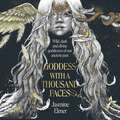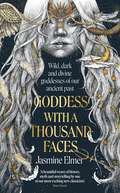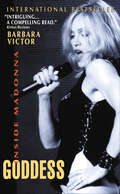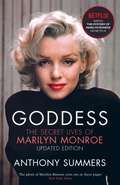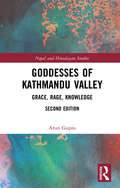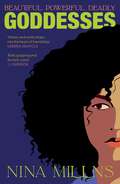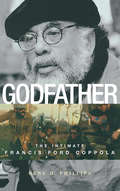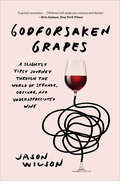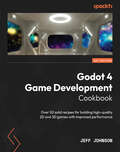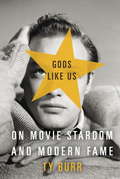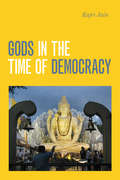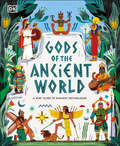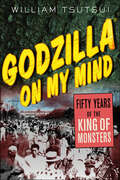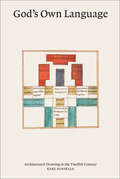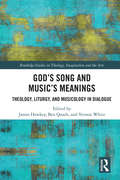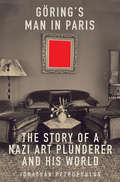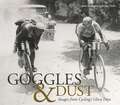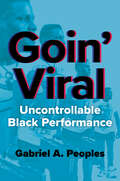- Table View
- List View
Goddess with a Thousand Faces: A one-of-a-kind exploration of goddesses from our ancient past
by Jasmine Elmer'I loved Goddess with a Thousand Faces. Fascinating, fun and thoughtful and enlightening' JENNIFER SAINT'A beautiful weave of history, myth and storytelling by one of our most exciting new classicists' DAN SNOWSteeped in ancient magic, dark divinity and wild ways, Goddess with a Thousand Faces takes you on a historical journey like no other...Blending mythological retellings with historical research, Goddess with a Thousand Faces traverses the world and transports through time to bring ten formidable and inspiring ancient goddesses to life. Meet Artemis, the Greek goddess of the wilderness, never without her bow and arrow; Sedna, Inuit goddess of the ocean, guarding the icy waters and all its creatures; Isis, Egyptian goddess of healing, who dwells by the River Nile, just to name a few...Jasmine Elmer explores these goddesses of our past, uncovering their truths, their rebellion and their freedom. For too long, they have been written out of history; lost to the sands of time and stamped into silence. Goddess with a Thousand Faces restores these women to their glory. Pour over this treasure trove of myths, legends and mighty goddesses. Hear the messages echoing through the ages and see yourself in the faces of these icons. For while their stories might ancient, today they are more important - and more powerful - than ever.A treasure trove of beautiful storytelling and ancient wisdom, perfect for fans of Love in Colour by Bolu Babalola and Storyland by Amy Jeffs.'Gorgeous. Jasmine Elmer has a fierce passion for these women, and this shines through in her writing. Come for the goddesses, stay for the spiritual journey!' Lizzy Tiffin, author of Bad Girls of Ancient Greece'If you love history and feminist retellings, this is your next must-read. Goddess With a Thousand Faces is a thrilling exploration of lesser-known goddesses from around the world - offering a crash course in feminine myth and worship, with all its power, fury and wonder. I adored it' Rachel Blackmore, author of Costanza'A passionate ode to the inner goddess within us all, that blends a rich and vibrant introduction to a diverse array of cultures and mythologies with accessible retellings. Part mythical guide, part history compendium and part self-help handbook, Jasmine Elmer's sparkling debut offers up a refreshing, inclusive and powerfully feminist manifesto for what it means to be a goddess, ancient and modern' Emily Hauser, author of Mythica
Goddess with a Thousand Faces: A one-of-a-kind exploration of goddesses from our ancient past
by Jasmine Elmer'I loved Goddess with a Thousand Faces. Fascinating, fun and thoughtful and enlightening' JENNIFER SAINT'A beautiful weave of history, myth and storytelling by one of our most exciting new classicists' DAN SNOWSteeped in ancient magic, dark divinity and wild ways, Goddess with a Thousand Faces takes you on a historical journey like no other...Blending mythological retellings with historical research, Goddess with a Thousand Faces traverses the world and transports through time to bring ten formidable and inspiring ancient goddesses to life. Meet Artemis, the Greek goddess of the wilderness, never without her bow and arrow; Sedna, Inuit goddess of the ocean, guarding the icy waters and all its creatures; Isis, Egyptian goddess of healing, who dwells by the River Nile, just to name a few...Jasmine Elmer explores these goddesses of our past, uncovering their truths, their rebellion and their freedom. For too long, they have been written out of history; lost to the sands of time and stamped into silence. Goddess with a Thousand Faces restores these women to their glory. Pour over this treasure trove of myths, legends and mighty goddesses. Hear the messages echoing through the ages and see yourself in the faces of these icons. For while their stories might ancient, today they are more important - and more powerful - than ever.A treasure trove of beautiful storytelling and ancient wisdom, perfect for fans of Love in Colour by Bolu Babalola and Storyland by Amy Jeffs.'Gorgeous. Jasmine Elmer has a fierce passion for these women, and this shines through in her writing. Come for the goddesses, stay for the spiritual journey!' Lizzy Tiffin, author of Bad Girls of Ancient Greece'If you love history and feminist retellings, this is your next must-read. Goddess With a Thousand Faces is a thrilling exploration of lesser-known goddesses from around the world - offering a crash course in feminine myth and worship, with all its power, fury and wonder. I adored it' Rachel Blackmore, author of Costanza'A passionate ode to the inner goddess within us all, that blends a rich and vibrant introduction to a diverse array of cultures and mythologies with accessible retellings. Part mythical guide, part history compendium and part self-help handbook, Jasmine Elmer's sparkling debut offers up a refreshing, inclusive and powerfully feminist manifesto for what it means to be a goddess, ancient and modern' Emily Hauser, author of Mythica
Goddess with a Thousand Faces: A one-of-a-kind exploration of goddesses from our ancient past
by Jasmine Elmer'I loved Goddess with a Thousand Faces. Fascinating, fun and thoughtful and enlightening' JENNIFER SAINT'A beautiful weave of history, myth and storytelling by one of our most exciting new classicists' DAN SNOWSteeped in ancient magic, dark divinity and wild ways, Goddess with a Thousand Faces takes you on a historical journey like no other...Blending mythological retellings with historical research, Goddess with a Thousand Faces traverses the world and transports through time to bring ten formidable and inspiring ancient goddesses to life. Meet Artemis, the Greek goddess of the wilderness, never without her bow and arrow; Sedna, Inuit goddess of the ocean, guarding the icy waters and all its creatures; Isis, Egyptian goddess of healing, who dwells by the River Nile, just to name a few...Jasmine Elmer explores these goddesses of our past, uncovering their truths, their rebellion and their freedom. For too long, they have been written out of history; lost to the sands of time and stamped into silence. Goddess with a Thousand Faces restores these women to their glory. Pour over this treasure trove of myths, legends and mighty goddesses. Hear the messages echoing through the ages and see yourself in the faces of these icons. For while their stories might ancient, today they are more important - and more powerful - than ever.A treasure trove of beautiful storytelling and ancient wisdom, perfect for fans of Love in Colour by Bolu Babalola and Storyland by Amy Jeffs.'Gorgeous. Jasmine Elmer has a fierce passion for these women, and this shines through in her writing. Come for the goddesses, stay for the spiritual journey!' Lizzy Tiffin, author of Bad Girls of Ancient Greece'If you love history and feminist retellings, this is your next must-read. Goddess With a Thousand Faces is a thrilling exploration of lesser-known goddesses from around the world - offering a crash course in feminine myth and worship, with all its power, fury and wonder. I adored it' Rachel Blackmore, author of Costanza'A passionate ode to the inner goddess within us all, that blends a rich and vibrant introduction to a diverse array of cultures and mythologies with accessible retellings. Part mythical guide, part history compendium and part self-help handbook, Jasmine Elmer's sparkling debut offers up a refreshing, inclusive and powerfully feminist manifesto for what it means to be a goddess, ancient and modern' Emily Hauser, author of Mythica
Goddess: Inside Madonna
by Barbara VictorGoddess is the book that Madonna and her entourage did not want published. Long before the star could instruct her family and friends not to talk to the author, Barbara Victor spent more than eighteen months in Michigan, the United Kingdom, France, Italy, California, New York, and Florida, interviewing Madonna's father and stepmother, her grandmother and other family members, as well as friends, neighbors, business associates, and former lovers and colleagues, some of whom knew the Ciccone family from the time Madonna was a young child, many of whom have never before spoken either on or off the record.In this extraordinary biography, Barbara Victor taps into previously unexplored sources to unmask the privet person behind the public image. As a result of her extensive research, Victor casts new light on every aspect of Madonna's career and private life -- from her childhood in Michigan to her early years in New York, from meteoric ascent to stardom to her most recent incarnation as an English wife and mother.After almost two decades, since she first appeared in the international music scene, Madonna continues to fascinate and challenge both her fans and her detractors. With her remarkable ability to reinvent herself -- from diva to provocateur, from artist to mogul -- she continues to command more attention and arouse more controversy than any other public figure of our time. Alternately criticized and revered, Madonna consistently and dramatically sets style, social, sexual, and musical trends and yet she remains an enigma to her public, keeping her most intimate identity hidden from all but her closest friends.Goddess offers explosive new revelations about Madonna's life, her career, and the fact or fantasy of her lesbian and heterosexual relationships. Barbara Victor has written the definitive biography about a woman who gives new meaning to the term superstar.
Goddess: The Secret Lives Of Marilyn Monroe
by Anthony SummersThe classic, definitive biography of Marilyn Monroe, now updated in the year of the 50th anniversary of the iconic star's deathShe was born Norma Jeane but the world knew and loved her as Marilyn. Her life was one of unprecedented fame and private misery, her death a tragedy surrounded by mysteries. Drawing on first-hand interviews Anthony Summers offers both a classic biography and a shockingly revealing account of the screen goddess's relations with John and Robert Kennedy.'The definitive story of the legend ... more convincing at every page - told with all the coldness of truth and the authority of the historian, but at the end of it we still love Marilyn' Maeve Binchy, Irish Times
Goddess: The Secret Lives Of Marilyn Monroe
by Anthony SummersMore than half a century after her death, Marilyn Monroe is arguably still one of the most famous people in the world. Her life was a contrast of public brilliance and private misery, her death a tragedy suffused by dark questions - about her relations with President John F. Kennedy and his brother Robert. Drawing on more than 600 first-hand interviews, Anthony Summers offers the classic, definitive biography of a woman who captivated the world. Marilyn's tragic story is clouded by gossip-reporting more than almost any other. GODDESS, however, delivers new, fully documented yet exciting fact.'Gets as near to the heart of the mystery as anyone ever will' Guardian'The fullest factual account of Monroe's life and death we're likely to get' Evening Standard'The definitive story of the legend' Irish Times'A remarkable performance...The ghost of Marilyn Monroe cries out in these pages' New York Times
Goddesses of Kathmandu Valley: Grace, Rage, Knowledge (Nepal and Himalayan Studies)
by Arun GuptoIn South Asia goddesses are conceptualized and worshipped in a fascinatingrange of forms – from cosmic beings to bacterial manifestations, from human-like appearances to creatures with animal and insect semblances. This book maps the diverse identities of goddesses through metaphors of Grace, Rage and Knowledge, and offers an in-depth insight into femininity, sexual politics, ritual worship, religion, ecology and gender. The volume explores how these deity attributes are expressed and embedded through anthropomorphic as well as inorganic forms of nature: beautiful women, multi-legged and many-armed animals, epistemic selves, demonic beings, glamorous personifications and also grotesque sub-humans. The second edition contains an Epilogue which further explores how the discourses on Goddesses are moulded by the myth and folklore. It opens discussions on how the dynamism of Goddess cultures have been appropriated into contemporary variations of those archetypes over time. This book will be useful to scholars and researchers of religious studies, cultural studies, folklore, art, literature, sociology and gender studies, especially those interested in Nepal and Hinduism.
Goddesses: 'Bold, gripping and divinely comic' T.J. Emerson
by Nina MillnsPRE-ORDER SAY YOU'LL BE THERE, THE INCREDIBLE NEW NOVEL BY NINA MILLNS COMING THIS SEPTEMBER!&‘Exciting, contemporary, heartfelt and clever&’ Greg Mosse&‘Riveting, real and raw . . . a powerful journey&’ Balvinder Sopal&‘Wisely and wittily leaps into the heart of friendships&’ Sabrina Mahfouz &‘Dares to subject modern feminism to a tough and timely cross-examination&’ T.J. EmersonThe hen party from hell descends into darkness, perfect for fans of Nikki May, Dawn O&’Porter and Zakiya Dalila HarrisSome friends have your back. Some friends stab you in the back. Ayesha is just about finding her feet on the London stand-up scene, but when her response to a sexist heckler goes viral, she finds herself drawn into an exclusive group of activists: a sacred circle of change makers, each woman with a specific gift to contribute to the cause. The circle draws in her friend Yaz too and they are both invited to an intimate hen do, except it&’s not a hen do – it's a Goddess Retreat. While Ayesha, longing to find her tribe, tries desperately to fit herself into a shape that the women will accept, Yaz treats the entire &‘itinerary&’ with open disdain. But the Goddess Retreat is no laughing matter. As the weekend descends into chaos, they&’ll need to stick together if they want to get out alive.Goddesses is a bitingly brilliant novel that explores the power dynamics of sisterhood and activism, the dark side of white feminism and the importance of making your voice heard.READERS LOVE GODDESSES &‘Captivating&’ &‘Thrilling&’ &‘Filled with unexpected twists&’ &‘So damn INTENSE&’
Godfather: The Intimate Francis Ford Coppola
by Gene D. PhillipsThis critical biography by the acclaimed film historian is &“certainly the definitive work on the director&” behind The Godfather and Apocalypse Now (Publishers Weekly). Gene Phillips blends biography, studio history, and film criticism to complete the most comprehensive work on Coppola ever written. The force behind such popular and critically acclaimed films as Rumble Fish and the Godfather trilogy, Coppola has imprinted his distinct style on each of his movies and on the landscape of American popular culture. In Godfather, Phillips argues that Coppola has repeatedly bucked the Hollywood "factory system" in an attempt to create distinct films that reflect his own artistic vision—often to the detriment of his career and finances. Phillips conducted interviews with the director and his colleagues and examined Coppola's production journals and screenplays. Phillips also reviewed rare copies of Coppola's student films, his early excursions into soft-core pornography, and his less celebrated productions such as One from the Heart and Tucker: The Man and His Dream. The result is the definitive assessment of one of Hollywood's most enduring and misunderstood mavericks.
Godforsaken Grapes: A Slightly Tipsy Journey through the World of Strange, Obscure, and Underappreciated Wine
by Jason WilsonA New York Times and Smithsonian Magazine best book, this &“genial excursion&” to little-known wine destinations &“will make you curious and thirsty.&” (Eric Asimov, The New York Times). Eighty percent of the wine we drink is made from only twenty grapes. Yet, there are nearly 1,400 known varieties of wine grapes in the world—from altesse to zierfandler. In Godforsaken Grapes, Jason Wilson looks at how that came to be and embarks on a journey to discover what we miss. Stemming from his own growing obsession, Wilson moves far beyond the &“noble grapes,&” hunting down obscure and underappreciated wines from Switzerland, Austria, Portugal, France, Italy, the United States, and beyond. In the process, he looks at why these wines fell out of favor (or never gained it in the first place), what it means to be obscure, and how geopolitics, economics, and fashion have changed what we drink. A combination of travel memoir and epicurean adventure, Godforsaken Grapes is an entertaining love letter to wine. &“You&’ll walk away with a better understanding of the wine industry and an itch to book a ticket to destinations you&’ve never heard of before.&” —Imbibe Magazine &“Funny, enlightening [and] prodigiously researched.&” —San Francisco Chronicle &“Wilson offers a spirited, highly personal argument for drinking more adventurously.&” —Punch &“A delightful dive into more esoteric grapes.&” —Minneapolis Star-Tribune &“Wonderful . . . [you&’ll] never order another pinot noir again.&” —Tom Bissell, author of Apostle and The Disaster Artist &“Original, obsessive, and wildly insightful. Drink it down!&” —Andrew McCarthy, actor, director, and author of the New York Times bestselling travel memoir The Longest Way Home
Godot 4 Game Development Cookbook: Over 50 solid recipes for building high-quality 2D and 3D games with improved performance
by Jeff JohnsonExplore the latest features of Godot 4 using advanced techniques and recipes to create professional-grade games with increased efficiencyPurchase of the print or Kindle book includes a free PDF eBookKey FeaturesTake advantage of the new Vulkan renderer and 3D physics in Godot 4 to create high-quality gamesStreamline your game development workflow with Godot's new TileMap, TileSet, and Animation Editor featuresDiscover what's changed in GDScript 2.0 and Shader additions to enhance your game development skillsBook DescriptionWant to transition from Godot 3 to 4? Look no further than the Godot 4 Game Development Cookbook. This comprehensive guide covers everything you need to become proficient with the latest GUI, GDscript 2.0, Vulkan 2D/3D rendering, shaders, audio, physics, TileSet/TileMap, importing, sound/music, animation, and multiplayer workflows. With its detailed recipes, the book leaves no stone unturned. The Godot 4 Cookbook begins by exploring the updated graphical user interface and helps you familiarize yourself with the new features of GDscript 2.0. Next, it delves into the efficient rendering of 2D and 3D graphics using the Vulkan renderer. As it guides you in navigating the new Godot 4 platform, the book offers an in-depth understanding of shaders, including the latest enhancements to the shader language. Moreover, it covers a range of other topics, including importing from Blender, working with audio, and demystifying the new Vulkan Renderer and the physics additions for 2D and 3D. The book also shows you how the new changes to TileSet and TileMap make 2D game development easy. Advanced topics such as importing in Godot 4, adding sound and music to games, making changes in the Animation editor, and including workflows for multiplayer in Godot 4 are covered in detail. By the end of this game development book, you'll have gained a better understanding of Godot 4 and will be equipped with various powerful techniques to enhance your Godot game development efficiency.What you will learnSpeed up 2D game development with new TileSet and TileMap updatesImprove 2D and 3D rendering with the Vulkan RendererMaster the new animation editor in Godot 4 for advanced game developmentEnhance visuals and performance with visual shaders and the updated shader languageImport Blender blend files into Godot to optimize your workflowExplore new physics system additions for improved realism and behavior of game objectsExperience innovative features by building multiplayer games in Godot 4Who this book is forThe Godot 4 Game Development Cookbook is for seasoned game developers who want to acquire skills in creating games using a contemporary game engine. It is an invaluable resource for indie game developers and Godot developers who are familiar with Godot 3 and have some level of expertise in maneuvering the interface.
Gods Like Us
by Ty BurrWITH 8 PAGES OF BLACK-AND-WHITE PHOTOGRAPHSHow--and why--do we obsess over movie stars? How does fame both reflect and mask the person behind it? How have the image of stardom and our stars' images altered over a century of cultural and technological change? Do we create celebrities, or do they create us? Ty Burr, film critic for The Boston Globe, answers these questions in this lively and fascinating anecdotal history of stardom, with all its blessings and curses for star and stargazer alike. From Mary Pickford and Charlie Chaplin to Archie Leach (a.k.a. Cary Grant) and Marion Morrison (a.k.a. John Wayne), Tom Cruise and Julia Roberts, and such no-cal stars of today as the Kardashians and the new online celebrity (i.e., you and me), Burr takes us on an insightful and entertaining journey through the modern fame game at its flashiest, most indulgent, occasionally most tragic, and ultimately, its most revealing.ine celebrity (i.e., you and me), Burr takes us on a brilliantly insightful and entertaining journey through the modern fame game at its flashiest, its most indulgent, occasionally its most tragic and, ultimately, its most culturally revealing.From the Hardcover edition.
Gods and Monsters: A Queer Film Classic
by Noah TsikaGods and Monsters, one of three inaugural titles in Arsenal Pulp Press' new film book series Queer Film Classics, deals with the acclaimed 1998 film about openly gay film director James Whale, best known for the Frankenstein films of the 1930s.<P> Written and directed by Bill Condon (Dreamgirls), Gods and Monsters stars Ian McKellen as Whale in the final days of his life during the 1950s. Moving from the slums of Britain in the early twentieth century to the new era of "talkies" in Hollywood and beyond, Gods and Monsters trains a gay eye on the historical events that helped shape Whale and his films. The result was widely acclaimed, winning an Oscar for Condon's screenplay and nominations for both McKellen and costar Lynn Redgrave.<P> This book examines Gods and Monsters from a variety of perspectives, highlighting the complexity and significance of its achievements, including its fusion of fantasy and biography. It also delves into a history of gay Hollywood during this era, including both its homophobic surface and its queer underpinnings.
Gods in the Bazaar: The Economies of Indian Calendar Art
by Kajri JainGods in the Bazaar is a fascinating account of the printed images known in India as "calendar art" or "bazaar art," the color-saturated, mass-produced pictures often used on calendars and in advertisements, featuring deities and other religious themes as well as nationalist leaders, alluring women, movie stars, chubby babies, and landscapes. Calendar art appears in all manner of contexts in India: in chic elite living rooms, middle-class kitchens, urban slums, village huts; hung on walls, stuck on scooters and computers, propped up on machines, affixed to dashboards, tucked into wallets and lockets. In this beautifully illustrated book, Kajri Jain examines the power that calendar art wields in Indian mass culture, arguing that its meanings derive as much from the production and circulation of the images as from their visual features. Jain draws on interviews with artists, printers, publishers, and consumers as well as analyses of the prints themselves to trace the economies--of art, commerce, religion, and desire--within which calendar images and ideas about them are formulated. For Jain, an analysis of the bazaar, or vernacular commercial arena, is crucial to understanding not only the calendar art that circulates within the bazaar but also India's postcolonial modernity and the ways that its mass culture has developed in close connection with a religiously inflected nationalism. The bazaar is characterized by the coexistence of seemingly incompatible elements: bourgeois-liberal and neoliberal modernism on the one hand, and vernacular discourses and practices on the other. Jain argues that from the colonial era to the present, capitalist expansion has depended on the maintenance of these multiple coexisting realms: the sacred, the commercial, and the artistic; the official and the vernacular.
Gods in the Time of Democracy
by Kajri JainIn 2018 India's prime minister, Narendra Modi, inaugurated the world's tallest statue: a 597-foot figure of nationalist leader Sardar Patel. Twice the height of the Statue of Liberty, it is but one of many massive statues built following India's economic reforms of the 1990s. In Gods in the Time of Democracy Kajri Jain examines how monumental icons emerged as a religious and political form in contemporary India, mobilizing the concept of emergence toward a radical treatment of art historical objects as dynamic assemblages. Drawing on a decade of fieldwork at giant statue sites in India and its diaspora and interviews with sculptors, patrons, and visitors, Jain masterfully describes how public icons materialize the intersections between new image technologies, neospiritual religious movements, Hindu nationalist politics, globalization, and Dalit-Bahujan verifications of equality and presence. Centering the ex-colony in rethinking key concepts of the image, Jain demonstrates how these new aesthetic forms entail a simultaneously religious and political retooling of the “infrastructures of the sensible.”
Gods of the Ancient World: A Kids’ Guide to Ancient Mythologies
by Marchella WardUncover the stories of gods and goddesses from around the world, in this dynamic anthology of ancient myths.Discover 23 captivating stories of gods and goddesses from civilizations around the world in this book that introduces children to ancient cultures with colorful illustrations and incredible storytelling. Young readers will delight in myths that explain the beginning of the world, the way gods helped humans, the divine's power over weather and other natural phenomena, and much more. Gods of the Ancient World is a perfect global introduction to the most fascinating stories about gods and goddesses from ancient history. Further featuring: - The incredible myths and legends behind each god or goddess with real-world art references. - Illustrations bring each god and goddess to life for a young audience.- Fact boxes call out key information to draw the reader in.- A global look at mythologies, with Maya, Japanese and Yoruba deities as well as Ancient Greek and Roman gods.Authored by Classics expert Marchella Ward, a researcher at the University of Oxford, this beautifully illustrated treasury of ancient mythologies is perfect for children age 9-12, with amazing real-life photos of ancient objects which show how people worshipped the gods through art.
Godzilla on My Mind: Fifty Years of the King of Monsters
by William TsutsuiThis year, to mark the fiftieth anniversary of his first appearance on the screen, the original, uncut version of Godzilla was released in American theaters to the delight of Sci-Fi and B-Movie fans everywhere. Ever since Godzilla (or, Gojira, as he is known in Japan) crawled out of his radioactive birthplace to cut a swath of destruction through Tokyo, he has claimed a place alongside King Kong and others in the movie monster pantheon. He is the third most recognizable Japanese celebrity in the United States, and his fan base continues to grow as children today prove his enduring appeal. Now, Bill Tsutsui, a life-long fan and historian, takes a light-hearted look at the big, green, radioactive lizard, revealing how he was born and how he became a megastar. With humorous anecdotes, Godzilla on My Mind explores his lasting cultural impact on the world. This book is sure to be welcomed by pop culture enthusiasts, fans, and historians alike.
God’s Own Language: Architectural Drawing in the Twelfth Century
by Karl KinsellaHow modern architectural language was invented to communicate with the divine—challenging a common narrative of European architectural history.The architectural drawing might seem to be a quintessentially modern form, and indeed many histories of the genre begin in the early modern period with Italian Renaissance architects such as Alberti. Yet the Middle Ages also had a remarkably sophisticated way of drawing and writing about architecture. God&’s Own Language takes us to twelfth-century Paris, where a Scottish monk named Richard of Saint Victor, along with his mentor Hugh, developed an innovative visual and textual architectural language. In the process, he devised techniques and terms that we still use today, from sectional elevations to the word &“plan.&”Surprisingly, however, Richard&’s detailed drawings appeared not in an architectural treatise but in a widely circulated set of biblical commentaries. Seeing architecture as a way of communicating with the divine, Richard drew plans and elevations for such biblical constructions as Noah&’s ark and the temple envisioned by the prophet Ezekiel. Interpreting Richard and Hugh&’s drawings and writings within the context of the thriving theological and intellectual cultures of medieval Paris, Karl Kinsella argues that the popularity of these works suggests that, centuries before the Renaissance, there was a large circle of readers with a highly developed understanding of geometry and the visual language of architecture.
God’s Song and Music’s Meanings: Theology, Liturgy, and Musicology in Dialogue (Routledge Studies in Theology, Imagination and the Arts)
by Vernon White James Hawkey Ben QuashTaking seriously the practice and not just the theory of music, this ground-breaking collection of essays establishes a new standard for the interdisciplinary conversation between theology, musicology, and liturgical studies. The public making of music in our society happens more often in the context of chapels, churches, and cathedrals than anywhere else. The command to sing and make music to God makes music an essential part of the DNA of Christian worship. The book’s three main parts address questions about the history, the performative contexts, and the nature of music. Its opening four chapters traces how accounts of music and its relation to God, the cosmos, and the human person have changed dramatically through Western history, from the patristic period through medieval, Reformation and modern times. A second section examines the role of music in worship, and asks what—if anything—makes a piece of music suitable for religious use. The final part of the book shows how the serious discussion of music opens onto considerations of time, tradition, ontology, anthropology, providence, and the nature of God. A pioneering set of explorations by a distinguished group of international scholars, this book will be of interest to anyone interested in Christianity’s long relationship with music, including those working in the fields of theology, musicology, and liturgical studies.
Goering’s Man in Paris: The Story of a Nazi Art Plunderer and His World
by Jonathan PetropoulosA charged biography of a notorious Nazi art plunderer and his career in the postwar art world "[Petropoulos] brings Lohse into sharper focus, as a personality and axis point from which to explore a network of art dealers, collectors and museum curators connected to Nazi looting. . . . What emerges from Petropoulos&’s research is a portrait of a charismatic and nefarious figure who tainted everyone he touched."—Nina Siegal, New York Times&“With meticulous precision Jonathan uncovers the inner workings of the Nazi looting machine, exposing a network that lasted well into the 1960s. Indeed Göring&’s Man still casts a long shadow.&”—Simon Goodman, author of The Orpheus Clock Bruno Lohse (1911–2007) was one of the most notorious art plunderers in history. Appointed by Hermann Göring to Hitler&’s art looting agency in Paris, he went on to help supervise the systematic theft and distribution of more than thirty thousand artworks, taken largely from French Jews, and to assist Göring in amassing an enormous private art collection. By the 1950s Lohse was officially denazified but was back in the art dealing world, offering masterpieces of dubious origin to American museums. After his death, dozens of paintings by Renoir, Monet, and Pissarro, among others, were found in his Zurich bank vault and adorning the walls of his Munich home. Jonathan Petropoulos spent nearly a decade interviewing Lohse and continues to serve as an expert witness for Holocaust restitution cases. Here he tells the story of Lohse&’s life, offering a critical examination of the postwar art world.
Goggles & Dust: Images from Cycling's Glory Days
by The Horton CollectionDrawn from the one of the world's finest collections of cycling artifacts, Goggles & Dust collects over 100 stunning photographs from competitive cycling's heyday. Spanning the 1920s and '30s, Goggles & Dust: Images from Cycling's Glory Days celebrates the grit and determination of the bicycle racing pioneers who established the records, traditions, and distinct flavors of Europe's most hallowed races. The spirit of these hardy competitors was perhaps matched only by the resolve of the remarkable photographers who prevailed in all imaginable conditions, situations, altitudes and latitudes to capture unforgettable prints of the racers at work and play. From Alpine panoramas to hair-raising crashes and idyllic roadside celebrations, the gorgeous restored photographs in Goggles & Dust--most unseen since their original publication in the newspapers and magazines of the day--provide an indelible and delightful record of a more carefree and adventurous time.
Gogo Breeze: Zambia’s Radio Elder and the Voices of Free Speech
by Harri EnglundWhen Breeze FM, a radio station in the provincial Zambian town of Chipata, hired an elderly retired schoolteacher in 2003, no one anticipated the skyrocketing success that would follow. A self-styled grandfather on air, Gogo Breeze seeks intimacy over the airwaves and dispenses advice on a wide variety of grievances and transgressions. Multiple voices are broadcast and juxtaposed through call-ins and dialogue, but free speech finds its ally in the radio elder who, by allowing people to be heard and supporting their claims, reminds authorities of their obligations toward the disaffected. Harri Englund provides a masterfully detailed study of this popular radio personality that addresses broad questions of free speech in Zambia and beyond. By drawing on ethnographic insights into political communication, Englund presents multivocal morality as an alternative to dominant Euro-American perspectives, displacing the simplistic notion of voice as individual personal property—an idea common in both policy and activist rhetoric. Instead, Englund focuses on the creativity and polyphony of Zambian radio while raising important questions about hierarchy, elderhood, and ethics in the public sphere. A lively, engaging portrait of an extraordinary personality, Gogo Breeze will interest Africanists, scholars of radio and mass media, and anyone interested in the history and future of free speech.
Goin' Crazy with Sam Peckinpah and All Our Friends
by Max Evans Robert NottAlmost as famous for the legendary excesses of his personal life as for his films, Sam Peckinpah (1925–1984) cemented his reputation as one of the great American directors with movies such as The Wild Bunch and Pat Garrett and Billy the Kid. Max Evans, one of Peckinpah&’s best friends, experienced the director&’s mercurial character and personal demons firsthand. In this enthralling memoir we follow Evans and Peckinpah through conversations in bars, family gatherings, binges on drugs and alcohol, struggles with film producers and executives, and Peckinpah&’s abusive behavior—sometimes directed at Evans himself.Evans&’s stories—most previously unpublished—provide a uniquely intimate look at Peckinpah, their famous friends (including Lee Marvin, Brian Keith, Joel McCrea, and James Coburn), and the business of Hollywood in the 1960s and 1970s.
Goin' Viral: Uncontrollable Black Performance (New Black Studies Series)
by Gabriel A. PeoplesBlack virality refers to the spread of Black performance that becomes uncontrollable because of its rapid and ubiquitous circulation through popular media. Gabriel A. Peoples examines Black people and representations of Black people that have gone viral from the eighteenth century to today. Peoples’s analysis ranges from abolitionist and proslavery visual culture to Do the Right Thing to “Bed Intruder Song” and the cellphone video of Derrion Albert’s murder. After identifying these moments, he considers how performances go viral in Black ways. He also thinks through the ways Black virality circulates ideas that materially affect Black life. As he shows, an interacting person’s vulnerability to racialized gender and racialized sexuality knowledge inspires how they spread a performance. Non-iconic elements of viral moments reveal hard-to-find nuances of Black life while the artists and others represented in viral moments promote both collective and individual liberation by harnessing their visibility and audibility. Rigorous and expansive, Goin’ Viral uses Black virality as a new way to understand and frame Black performances.
Going Deep: 20 Classic Sports Stories
by Gary Smith Sports Illustrated EditorsA collection of essays by the award-winning Sports Illustrated writer highlights twenty of his most powerful pieces that range from "Shadow of a Nation," the story of a young Crow Indian basketball player and his efforts to escape the reservation, to "Blindsided by History," a saga of football, racism, and segregation.
